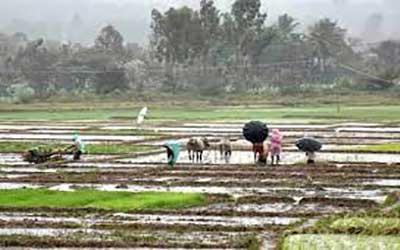Date: 05/05/2023
Relevance: GS-3: Major Crops - Cropping Patterns in various parts of the country, - Different Types of Irrigation and Irrigation Systems; Storage, Transport, and Marketing of Agricultural Produce and Issues and Related Constraints
Key Phrases: Unseasonal rain, economic and social impacts, rising input costs, changing weather patterns, changing weather patterns, Minimum Support Price, compensation for crop loss, Pradhan Mantri Fasal Bima Yojana, Soil Health Card Scheme, Pradhan Mantri Krishi Sinchai Yojana.
Why in News?
- Unseasonal rain has once again highlighted the vulnerabilities of India's agricultural sector, causing significant economic and social impacts.
The Impact of Unseasonal Rain:
- Impact on the Agricultural Sector:
- While rain is generally seen as a blessing, unseasonal rains can be a curse for farmers already reeling under the impact of low crop prices, rising input costs, and changing weather patterns.
- The recent unseasonal rain has not only affected the standing crops but has also impacted the post-harvest crops, leading to a rise in prices of perishable commodities such as vegetables and fruits. This can have a cascading effect on the overall inflationary trend.
- Impact on Other Industries:
- It can have far-reaching consequences for India's economy, not just for the agricultural sector but also for other industries such as construction.
- The disruption caused by unseasonal rains can lead to a rise in prices of key raw materials such as cement and steel, impacting the construction industry's growth
- Impact on Consumption Patterns:
- The rise in prices of essential commodities can also impact people's consumption patterns, leading to a fall in demand for non-essential goods and services.
- Social Impact on Vulnerable Sections of Society:
- The vulnerable sections of society such as small farmers, daily wage labourers, and migrant workers are the worst affected by unseasonal rains.
- These sections depend heavily on agriculture and allied activities for their livelihood and are the most susceptible to crop loss and income insecurity.
Short-term Measures:
- In the short term, the Centre and States can waive farm loans, provide compensation for crop loss, and supply seeds and fertilizers at subsidized rates.
- The Minimum Support Price could also be increased as a short-term measure to provide farmers with better remuneration for their crops.
Long-Term Measures:
- Structural Reforms for a Resilient Agricultural Sector:
- This can involve measures such as promoting crop diversification, encouraging the use of modern technologies and farming practices, and strengthening the supply chain infrastructure to reduce wastage and post-harvest losses.
- By diversifying crops, farmers can reduce their dependence on a single crop and reduce the risk of losses due to unseasonal rain.
- Modern technologies such as weather forecasting and remote sensing can help farmers better manage their crops and minimize the impact of unseasonal rain.
- Mitigating Climate Change:
- The issue of unseasonal rains also highlights the larger issue of climate change. India needs to take a proactive approach to mitigate its impact.
- This requires a coordinated effort between the Centre and States, civil society organizations, and the private sector.
- Investing in renewable energy, promoting sustainable agriculture practices, and implementing climate-resilient infrastructure are some of the ways to address climate change.
Government Measures:
- The government has launched several initiatives such as the Pradhan Mantri Fasal Bima Yojana (Prime Minister's Crop Insurance Scheme) and the Pradhan Mantri Krishi Sinchai Yojana (Prime Minister's Agricultural Irrigation Scheme) to address the concerns of farmers.
- The Soil Health Card Scheme provides farmers with a comprehensive report on the nutrient status of their soil and recommends corrective measures to optimize the use of fertilizers, reduce wastage, and improve soil health.
- The Pradhan Mantri Krishi Sinchai Yojana aims to boost irrigation infrastructure and promote water-use efficiency, helping farmers optimize their use of water resources, improve crop yields, and reduce the risk of crop failure due to droughts or water scarcity.
Political Impact:
- Unseasonal rain has a significant political impact, especially in the context of upcoming state and national elections.
- The ruling political party often faces criticism from the opposition for not doing enough to address the concerns of farmers.
- This leads to a political blame game, with each party trying to score points over the other.
Coordination between Central and State Governments:
- Coordination between the Central and State Governments is essential to address farmers' concerns effectively.
- The Centre can provide financial and technical support to the State governments to implement the initiatives at the ground level.
- The State Governments can take the lead in implementing the initiatives and providing support to the farmers.
Conclusion:
- Tackling unseasonal rain requires a multi-pronged approach that involves short- and long-term measures.
- While the government has launched several initiatives, there is a need for greater coordination between the Centre and States to address the concerns of farmers.
- By taking a proactive approach towards climate change, India can make its agricultural sector more resilient to changing weather patterns.
Source: The Hindu BL
Mains Question:
Q. Discuss the impact of unseasonal rain on the agricultural sector and the economy as a whole. Suggest short and long-term measures that can be taken to address the concerns of farmers and make the sector more resilient to changing weather patterns.






















